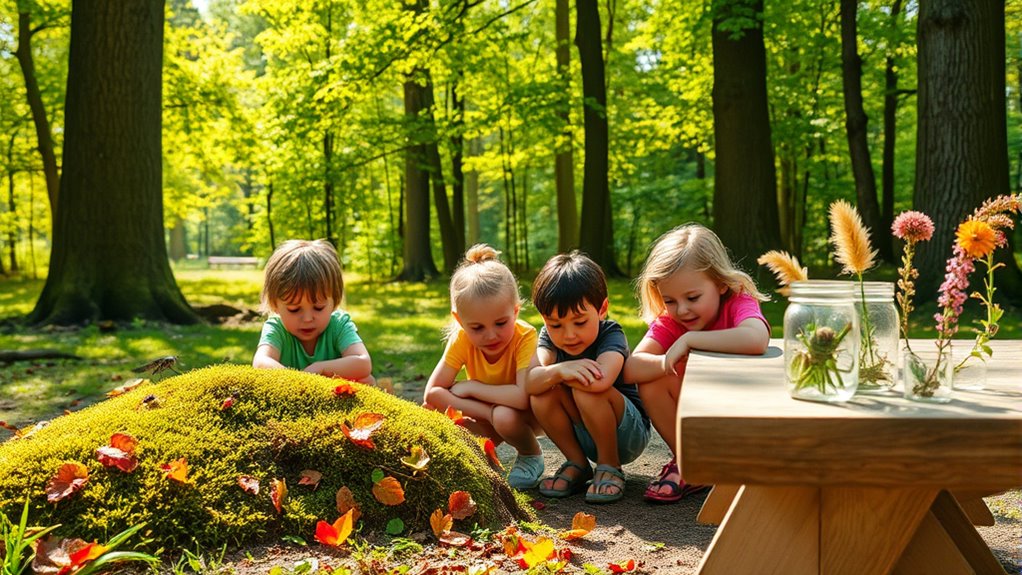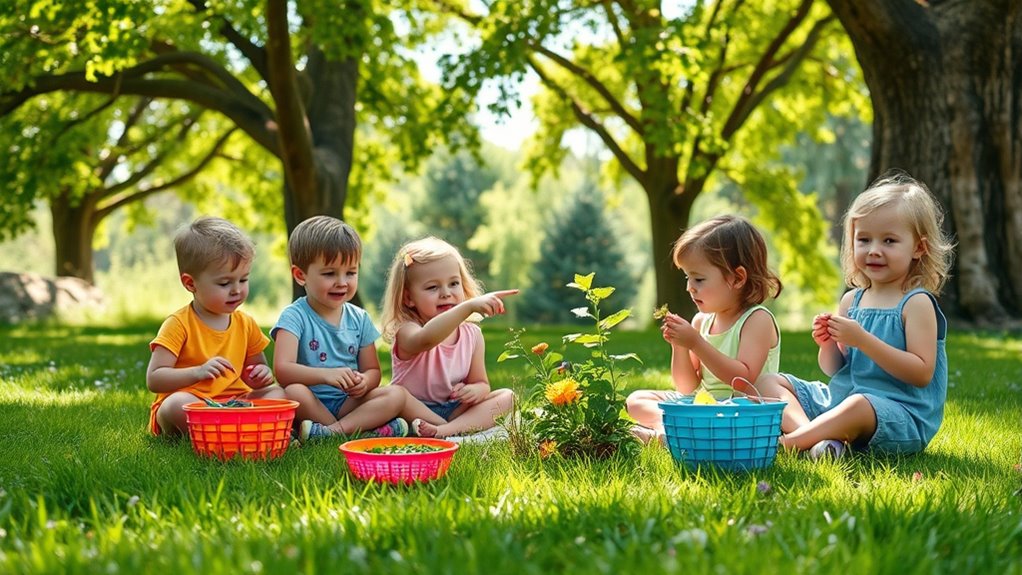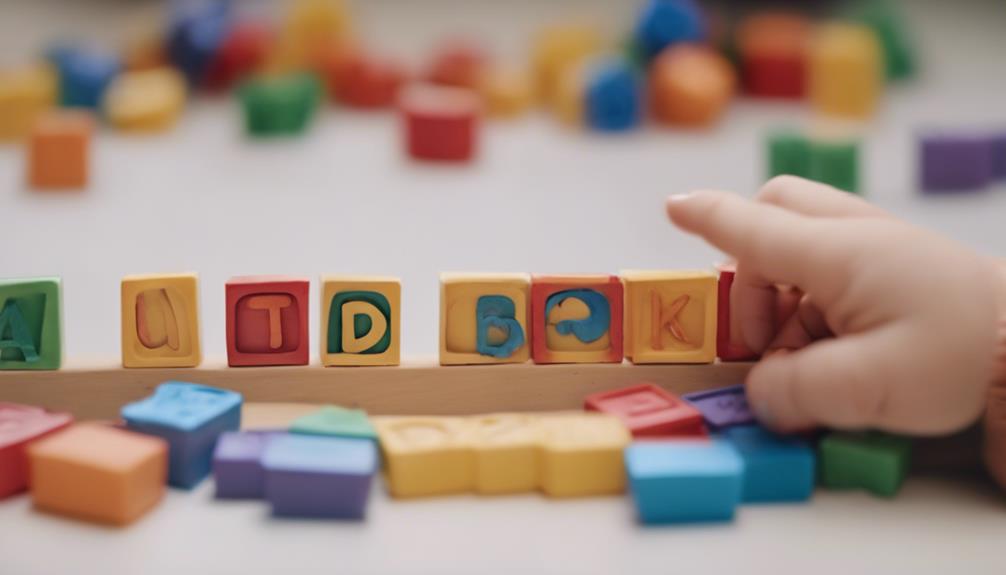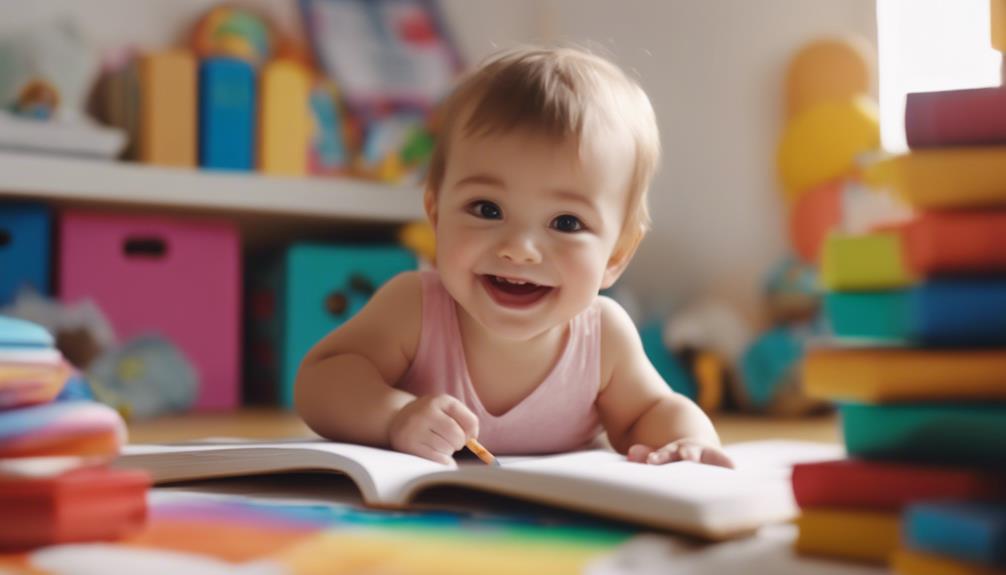Using nature as a classroom, you can engage toddlers in outdoor activities that promote sensory exploration and curiosity. Encourage them to explore natural objects like leaves, rocks, and flowers, which enhance tactile and visual skills. Activities like scavenger hunts, water play, and nature walks help develop observation, classification, and problem-solving abilities. Incorporating these hands-on experiences nurtures a love for discovery. Keep exploring to discover more fantastic ways to turn outdoor spaces into vibrant learning environments.
Key Takeaways
- Incorporate scavenger hunts to teach categorization and observation of natural objects like leaves and rocks.
- Use sensory trays with sand, water, or rice for tactile exploration and fine motor skill development.
- Engage toddlers in collecting and examining natural materials such as pinecones, petals, and acorns.
- Facilitate outdoor nature walks with guided discussions to enhance vocabulary and awareness of the environment.
- Create hands-on activities like water play or mud exploration to promote problem-solving and sensory learning.

Outdoor activities offer the perfect opportunity to combine play and learning for your toddler. When you take your little one outside, you’re opening the door to countless chances for nature exploration and sensory play that can boost their development. Toddlers are naturally curious, and in the outdoors, they can engage all their senses, helping them understand the world around them more deeply. Whether it’s feeling the rough bark of a tree or listening to the chirping birds, every moment outside becomes a learning experience.
Outdoor play sparks curiosity and sensory discovery, enriching your toddler’s understanding of the natural world around them.
As you encourage your toddler to explore nature, you’re helping them develop important skills like observation, classification, and problem-solving. For example, you might go on a walk through the park and point out different leaves, rocks, or insects. Let your child pick up and examine these objects—this kind of sensory play enhances their tactile awareness and fine motor skills. Touching different textures, from soft moss to smooth stones, allows them to learn about the variety of natural materials. Talking about what they see, hear, and feel reinforces language development and helps them connect words with real-world objects.
Creating simple activities focused on nature exploration can be both fun and educational. You could set up a scavenger hunt where your toddler searches for specific items, like a pinecone or a feather. As they collect these objects, they practice categorization and develop an understanding of different natural elements. You might also introduce water play, such as pouring water onto leaves or playing with mud—these activities provide rich sensory input that stimulates curiosity and enhances their understanding of cause and effect.
Incorporating sensory play into outdoor activities doesn’t have to be complicated. You can bring along a shallow tray filled with sand or rice, allowing your child to dig and explore textures. Playing with natural materials like acorns, flower petals, or pine needles also encourages fine motor skills and sensory awareness. These activities help your toddler learn through their senses, fostering curiosity and a love for discovery. Plus, they can help your child develop patience and focus as they manipulate and explore different textures.
Frequently Asked Questions
How Can Outdoor Activities Be Adapted for Different Weather Conditions?
You can adapt outdoor activities for different weather conditions by considering weather variability and seasonal changes. During rainy days, incorporate waterproof gear and indoor alternatives like nature-themed crafts. In cold weather, dress toddlers warmly and choose sheltered locations. For hot days, schedule activities early or late, provide shade, and guarantee hydration. These seasonal adaptations help keep outdoor learning safe and enjoyable, regardless of the weather.
What Safety Precautions Should Parents Take During Outdoor Educational Activities?
When planning outdoor educational activities, you should prioritize safety by following supervision guidelines and maintaining close oversight of your toddler. Always assess hazard awareness beforehand, checking for sharp objects, uneven surfaces, or plants that might be toxic. Keep a first aid kit nearby, and ensure your child wears appropriate clothing and sun protection. Regularly remind them of safety rules to prevent accidents and create a safe, enjoyable learning environment.
How Do Outdoor Activities Support Toddlers’ Emotional Development?
Outdoor activities help you support your toddler’s emotional development by fostering emotional resilience and encouraging social bonding. When they explore nature, they learn to manage emotions like excitement and frustration, building resilience. Playing with others outdoors enhances social skills and trust, strengthening bonds. You can observe their emotional growth as they navigate new environments and interact with peers, helping them become confident, empathetic individuals.
Are There Specific Outdoor Activities Recommended for Urban Environments?
Imagine turning city spaces into magical learning adventures. In urban environments, you can create engaging activities like city scavenger hunts that spark curiosity and exploration. Visiting urban parks offers a safe, vibrant backdrop for toddlers to discover nature’s wonders. These activities foster curiosity, confidence, and social skills, making outdoor play meaningful even amidst city life. Embrace these outdoor adventures to nurture your child’s growth in the heart of the city.
How Can Parents Encourage Curiosity During Nature-Based Learning?
To encourage curiosity during nature-based learning, you should engage your toddler in sensory exploration by encouraging them to touch, smell, and listen to their surroundings. Ask open-ended questions like “What do you see?” or “How does that feel?” to spark their interest and thinking. This active participation helps your child discover and connect with nature, fostering curiosity and a love for the outdoors.
Conclusion
Imagine your toddler discovering a hidden treasure in the backyard—each leaf, pebble, or bug becomes a precious gem. Just like explorers, children learn best when they’re immersed in nature’s classroom. Studies show outdoor activities boost their creativity and curiosity. So next time you step outside, remember you’re opening a world of endless possibilities. Nature isn’t just scenery; it’s the most inspiring classroom you can offer your little one.










